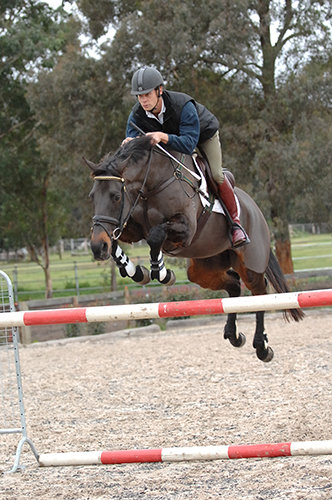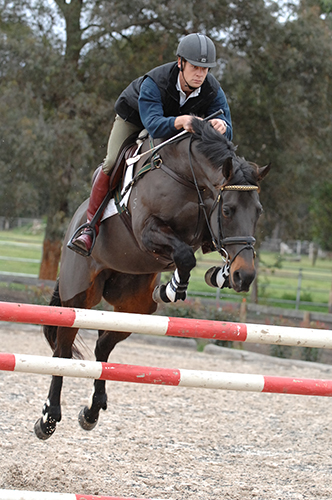 Story by Christopher Hector & Photos by Roslyn Neave
Story by Christopher Hector & Photos by Roslyn Neave
Christopher Burton, like most top riders, is a Thinking Rider. Every time he rides he has an objective and a strategy to achieve that goal. He’s like that at home training, thinking, analysing all the time, and – for the benefit of the journalist sitting on the edge of the ring – keeping up a running commentary as he rides…
“Really the warmup for the showjump phase, especially for a three day event, is no different from any other warmup, but you have to remember there is such a thing as jumping a tired horse, and on the third day of a three day event, that can influence your thinking. Still the aim of the warmup is the same for dressage, cross country and showjumping… you want to end up with a horse that is loose and soft.”
“At a three day event, I like to jump my horse as early as possible after the final trot up. That way I get an indication of how my horse is feeling, how much horse is left. It also means that I don’t have to warm up too much before the actual showjumping and I can save my best fences for the ring.”
“The important thing is to know your horse and always have a plan in your head, and that plan will depend on the horse.”
“I don’t change the bit for the showjumping. All my horses go in snaffles, but I have had horses that I thought needed a stronger bit, and in that situation it is a good idea, but I still maintain that if they are schooled well enough on the flat it should carry over into the cross country riding and therefore into your showjumping riding. You shouldn’t have a cut mouth, you shouldn’t have a problem on the third day.”
“The other important thing is to have useful staff and helpers – they can be crucial. You don’t want to end up doing too many warmup jumps because you made a mistake.”
“In the warmup arena, you need a clear plan for every fence. I want to know what I’m aiming to achieve on every fence – I can’t afford to waste them. Provided they are warmed up, and soft and happy, I want to do as little as possible. It does happen that by the end of 12 or 13 fences on a big track, they are getting a little tired and starting to fall through the fences, or they get sick of leaving them up. The idea is not to over-do it in the warmup, but if they are not switched on enough, you have to do just enough to get the result. A ten or twenty minute warmup, nothing too exciting.”
 “If the horse is a bit fiery, then you might trot to a cross rail to get him settled. Others need to be woken up, so I’d go straight to a small vertical. If you get the lethargic, tired horse, that might have been a little bit spent from the day before, I will find myself maybe even forcing him to hit the front rail if he is not watching enough. Maybe a bit bigger fence to get him in the air, within reason though. That was my point about not wasting your fences in the warmup. With a horse like that, you are looking for a very energetic, active canter, trying to create something off the ground. There are a few different rides that will produce a ‘rub’. The one I see a lot of riders do – and I think this is a mistake on a tired eventer – is cantering in weak to a wide oxer, to try and maybe have the back rail, or have them really work to get over it. Unless the horse is an exceptional jumper, I don’t think that helps them, it scares them – and it doesn’t create ‘ping’ off the ground.”
“If the horse is a bit fiery, then you might trot to a cross rail to get him settled. Others need to be woken up, so I’d go straight to a small vertical. If you get the lethargic, tired horse, that might have been a little bit spent from the day before, I will find myself maybe even forcing him to hit the front rail if he is not watching enough. Maybe a bit bigger fence to get him in the air, within reason though. That was my point about not wasting your fences in the warmup. With a horse like that, you are looking for a very energetic, active canter, trying to create something off the ground. There are a few different rides that will produce a ‘rub’. The one I see a lot of riders do – and I think this is a mistake on a tired eventer – is cantering in weak to a wide oxer, to try and maybe have the back rail, or have them really work to get over it. Unless the horse is an exceptional jumper, I don’t think that helps them, it scares them – and it doesn’t create ‘ping’ off the ground.”
“With Deo, my old horse, that sort of ride worked, it would wake him up. But with most horses you want to create that energetic canter. Maybe get a little deeper to the front rail and make them really work is not such a bad idea in the warmup every now and then.”
“Then you get the ones that come off the cross country track all steamed up and hanging on the bridle. That’s why I like to ride them in the morning straight after the trot up. Once again, we are talking about our flatwork – making sure they are coming back when you ask them, checking that their mouth is okay, getting them a little soft and supple again, so they are not just running like they were the day before.”
“But nowadays, the good riders are not riding cross country like that, so we are seeing less and less horses that come off the cross country track all fired up. But you do get hot horses, and with them, I’d still do a structured warmup, then square up an oxer. But with those ones, it’s quite easy to scare them by running through a fence, then they can’t think how to jump a fence, and they get worse. It is all about knowing your horse, and about thinking clearly about the structure of the warmup, and even practising your warmup at the competition before you go to the Three Day Event.”
“These days we also have to be on horses that are careful enough jumpers. Of course you get stuck with a few that aren’t but if we could all be on careful horses, it would make it a lot easier, and then you don’t have to do much in the warmup at all.”
“This horse is careful enough so I’ll go to the cross rail straight away.”
“The height of your warmup fence should be relative to the height of the round. If it’s a one star event, there is no point putting the practice fence up and scaring a green horse.”
“It’s important to gauge what he is telling you. If he is careful and watching – don’t jump so much.”
“Of course you want them careful so you might invite a little rub, but you don’t need a rub if they are careful. This guy is careful, and he needs to be confident to jump his best fence.”
Right on cue, Newsprint rolls a rail…
“It’s great if you can get an ‘innocent’ rub like that one. I’ve cantered in, and given him enough room to jump the fence, and he’s had a rail. That’s the best rub you can have. You see some riders and they are frantic to get a rub in the warmup arena, and they just scare the horse. You’ll see riders putting up huge fences and their horse is trying really hard and not touching anything – then they’ll go in the ring and have two rails. That’s called wasting your best fences in the practice ring.”
“Depending on the room you have in the warmup area, it’s good to come to the jump off the left and the right reins – but again be conscious of not jumping too many fences.”
“A rising oxer is a good way to keep them happy and get them in the air. If the horse is a little tired and you are worried about him not watching, then a square oxer is a good idea just before you go in.”
“You are trying to always get a similar ride and distance to the fence – let him make the mistake if he is going to make one. This guy watches and sometimes – especially after cross country – he backs up a bit, so I might give him a tap with the stick on a warmup fence, and hope that carries through to the round… just a touch in the warmup if you feel the need, but what you don’t want is to find that you are reaching for the stick half way round the course!”
 “For my final fence I might just pop a slightly bigger vertical.”
“For my final fence I might just pop a slightly bigger vertical.”
“The timing is very important. You don’t want to be standing around getting cold waiting to go in. That’s where good ground staff are important…”
“I think that one thing that really helps is that I have trained all my horses using the same warmup routine. I ride every horse in exactly the same way, that is important because if we go to a competition where it is indoors for example, where the young ones might be a bit spooky, at least the warmup is familiar, and they can stretch and relax, and hopefully that carries over into my round.”


